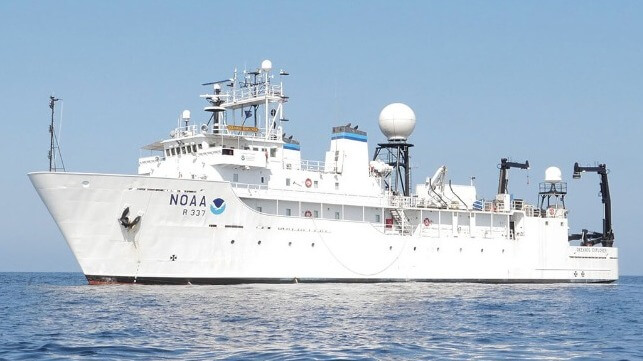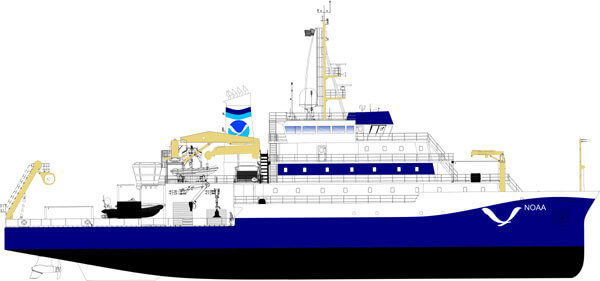Construction Begins on NOAA’s New Oceanographic Research Ships

Construction officially began on June 15 for the first of two oceanographic ships as part of the fleet rebuilding effort for NOAA (National Oceanic and Atmospheric Administration). The agency celebrated a keel-laying ceremony recognizing the start of construction while demonstrating they are scientists by noting that the vessel does not have a traditional keel due to modern shipbuilding techniques.
The U.S. Navy awarded the $178 million contract for the detailed design and construction of the two vessels, to be named Oceanographer and Discoverer, in December 2020 to Thoma-Sea Marine Constructors, in Houma, Louisiana. Designed as single-hull ships, Oceanographer and Discoverer will be built to commercial standards. They will incorporate the latest technologies, including high-efficiency, environmentally friendly EPA Tier IV diesel engines, emissions controls for stack gases, new information technology tools for monitoring shipboard systems, and underwater scientific research and survey equipment.
“Today’s keel-laying ceremony marks a major step forward both in the construction of Oceanographer and the revitalization of NOAA’s ship fleet,” said Rear Adm. Nancy Hann, director of NOAA’s Office of Marine and Aviation Operations (OMAO) and the NOAA Commissioned Officer Corps.
During the ceremony, the initials of the ship’s sponsor, Linda Kwok Schatz, wife of U.S. Sen. Brian Schatz of Hawaii, were welded onto a steel plate that will be incorporated into the ship during construction. Expected to join the NOAA fleet in 2025, Oceanographer will be homeported in Honolulu, Hawaii. The second new ship, Discoverer, is expected to enter service in 2026 and will be homeported in Newport, Rhode Island.

Rendering of the new ships with a new livery for NOAA (NOAA)
The new ships will be equipped to launch work boats, perform maintenance on buoys and moorings, deploy scientific instruments to collect weather and water column data, and conduct seafloor mapping surveys. Each vessel will operate with a crew of 20 and will accommodate up to 28 scientists.
Currently, the NOAA Ship Okeanos Explorer, is the only federal vessel dedicated to exploring our largely unknown ocean for discovery and the advancement of knowledge about the deep ocean. The 224-foot vessel was obtained by NOAA in 2004 and commissioned in 2008. Before that she operated as the U.S. Naval Ship Capable, a T-AGOS class vessel. She is assigned by NOAA to conduct mapping operations and remotely operated vehicle (ROV) dives on unexplored and poorly understood deepwater areas on the Mid-Atlantic Ridge and Azores Plateau. She was due to depart on June 16 from St. John's, Newfoundland, but according to information NOAA’s website is currently delayed due to a mechanical issue. ”While we do not have a revised start date at this time, we will provide updates as soon as they are available, NOAA advises.
"NOAA ships play a vital role in meeting the large and growing demand for oceanic data, critical for protecting lives and livelihoods," said NOAA Administrator Rick Spinrad, Ph.D. "The new capabilities of Oceanographer will contribute to NOAA's sustained leadership in providing reliable, high-quality data to the nation, driving the New Blue Economy and doing so more efficiently than ever before."
Oceanographer will support a wide variety of missions, ranging from general oceanographic research and exploration to marine life, climate, and ocean ecosystem studies. These missions include shallow coastal, continental shelf, and worldwide ocean survey and data collection. NOAA had originally expected to replace its 1989-built ship Okeanos Explorer, but recently determined that Okeanos Explorer can continue to meet its ocean exploration mission requirements longer than expected, allowing Discoverer to undertake other missions, including shallow coastal, continental shelf and worldwide ocean survey and data collection when she enters service.
NOAA currently has a fleet of 15 research and survey ships, which are operated by OMAO and crewed by NOAA Corps officers and civilian professional mariners. Each year, NOAA ships conduct more than 100 missions to collect data critical for nautical charts, fishery quotas, exploration of the nation’s 4.3-million-square-mile Exclusive Economic Zone, storm surge modeling, and climate research.
